journalism/law/muckraking
Latest Vision Zero lunacy: Bike “corrals” replacing emergency access zones

You can point them to all sorts of evidence and statistics showing that in this country the results all too often are precisely the opposite. You can show them the many videos and images on YouTube and social media of emergency vehicles bogged down on reconfigured streets. You can point out statistics like the fact that pedestrian deaths have nearly doubled in Los Angeles after three and a half years of Vision Zero, or to California Highway Patrol SWITRS data revealing a nearly 10% increase in overall accidents the program’s first 18 months versus the previous 18 months. You can point out that even where Vision Zero produced promising early results, such as in San Francisco, progress has reversed over the last two years (even StreetsBlog SF has been forced to acknowledge that the initial drop in pedestrian deaths may have been an anomaly). You can tell them about the first responders who are nearly universal in their concerns over road diets on major arteries. You can even point out that many road diets, especially on those arteries, violate local and state fire codes as well as federal guidelines. You can point to grassroots groups resisting road diets from Queens, New York to Tahlequah, Oklahoma.
Their reaction is always the same: They slap their hands over their ears, shut their eyes, and call you a liar. They’ll accuse you of being “anti-bike,” which is a particularly insane bit of invective. Being anti-bike is like being anti-springtime, or anti-puppy. They’ll accuse you of callous indifferent to the lives of cyclists and pedestrians. At a road diet presentation a few months ago, we were even accused of complicity in children’s deaths. The irony is that the point of our presentation was to point out safety hazards created by certain road diets in Los Angeles.
So perhaps it’s no surprise that Vision Zero has come full circle: Across L.A. bike and scooter “corrals” are replacing emergency apparatus access zones. You can’t make this stuff up. In the name of safety, L.A. is making it harder for first responders to do their jobs. In the name of saving lives bureaucrats are reducing emergency apparatus accessibility.

Several firefighters, speaking as usual off the record because they’re criticizing the official line, were aghast at the corrals. “What planners never seem to grasp with these projects,” said one, “is that seconds and inches are life and death factors in an emergency.”
“Corrals” and other permanent or semi-permanent physical changes to roads are particularly insidious because they impact responders’ ability to stage emergency apparatus. This was demonstrated most clearly by a video made by a hook and ladder crew in Baltimore last year. Hook and ladders are all about angles: Where the apparatus is staged directly impacts where it can reach. In the video buffered bike lane – where parallel parking spaces are pushed out from the curb to protect a bike lane – prevented the ladder from reaching the top two floors of a six story building. Firefighters in New York have related similar experiences.
Baltimore’s response? The crew received an official rebuke, and the city council subsequently repealed part of its fire code to allow the configuration (Baltimore’s fire code, like the vast majority of cities and counties, is based on the authoritative International Fire Code, meaning the city council effectively decided they knew better than the experts). Again, you can’t make this stuff up. Cities are saying that bike lanes used by fewer than 1% of commuters are more important than fire crews’ ability to reach people. So if you’re on the fifth or sixth floor during a fire on those streets in Gotham or Charm City, best of luck. Again, these conclusions are based on scores of interviews with firefighters, officials, and other first responders nationwide.
By altering the physical configuration of streets, “corrals” can have a similar impact. At the very least, crews will spend precious seconds tossing bikes and scooters out of the way.
If you park a car in a red zone, not only will you get a whopper of a citation you’ll likely be towed, and rightly so. Yet somehow it’s o.k. to install permanent physical bike facilities in those same zones. Cities are even painting over the red.

Which leads to a final bit of insanity: Cities like San Francisco are purchasing “Vision Zero fire apparatus.” The SFFD has begun replacing its fleet with apparatus that are – wait for it – smaller. We hasten to add that smaller doesn’t necessarily mean less effective. Rather, Frisco’s decision reflects a broader national trend among planners in which fire and police departments are viewed as somehow adversarial to public safety. To its credit the SFFD has been one of the most vocal in the country in criticizing the one size fits all approach to Vision Zero.
It’s worth repeating: Cities and their planning and transportation departments need to be far more transparent when it comes to these changes. Randomly replacing emergency access zones with bicycle amenities is not the way to move forward. Ironically, by not involving first responders, community members, and business owners in these decisions cities are generating completely avoidable hostility to Vision Zero. Everyone loses under the current approach, including the very people the program is supposed to protect.
No comments:
Post a Comment